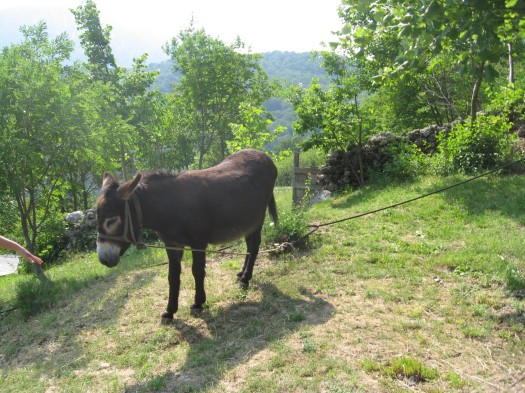I started writing this piece while in Croatia for my 30th birthday; it has not been published elsewhere, and all the photographs were taken by me.
JUNE 2011 — On arriving at Ramica Dvori, a mountain lodge tucked into the Velebit peaks at Paklenica National Park, we are offered shots of brandy.
The sweet brown liquid is our reward for nearly three hours of steep hiking under the hot sun, past adventurous climbers who scramble up sheer rock faces, and older tourists making shorter treks to drink coffee at mountain-base cafes.
Former sailor Marijo Ramic, who slips between Croatian, English and German as he congratulates his guests on making the hike, holds court. He offers food and other drinks prepared in his “black kitchen,” asks where people are from, and shows them the house where he was born and behind which his grocery-carrying donkeygrazes quietly.
This moment of community is one my Canadian friend and I have grown almost accustomed to since arriving in Zadar, on the northern coast of the Adriatic Sea. Croatian hospitality has made us the recipients of not one but two bowls of backyard-grown cherries courtesy of our landlord in the beach suburb of Puntamika, and, when taking a boat tour of the Kornati Islands, 9:30 a.m. vodka shots.
In tourism literature, Croatia markets itself as “The Mediterranean as it once was.”
The most straight-forward interpretation of the tourist tag line allows one to marvel at Zadar’s welcoming (and often English-speaking) residents, all the wonderful ways fresh fish can be prepared before arriving at your waterside dining table, and the region’s low prices.
Five hours, or 400 kilometres, north of Croatia’s largest tourist draw — Dubrovnik — Zadar and Northern Dalmatia see fewer visitors despite lower costs to fly here with cut-rate airlines out of London’s Stansted Airport. Where southern France, Italy and Greece can be expensive destinations this time of year, Croatia’s Kuna amounts to just a fifth of the Canadian dollar (or 12 British pence), making shopping and excursions relatively cheap for international travelers.
But like all places and people, Zadar’s history takes in a variety of experiences that often seem far removed from the softly rolling, green-blue waves that nudge rocky beaches.
From the grown-over remains of Iron Age cottages at Paklenica National Park to Roman ruins staged outside the Church of St. Donat in Zadar’s old town, much of the region’s ancient history is on display. But more recent histories — including Zadar’s years under siege during the “Homeland Wars” 20 years ago, and today’s debate over joining the European Union — are more difficult to ascertain.
Some may remember Rastevic, about 20 kilometres outside Zadar, as the base where Canadian peacekeepers spent the Christmas of 1994 before being escorted to Zadar by Croatian soldiers the following year. Although there is little visible evidence of the fighting today, Zadar saw rocket attacks to its outskirts in the early 1990s; by the middle of the decade, it was a staging port for thousands of Croatian troops preparing to face off against Bosnian Serbs in the aftermath of Croatia’s war for independence from the former Yugoslavia. At times isolated from southern Croatia, Zadar lay just 80 kilometres to the west of Knin, then described in one Edmonton Journal report as “the symbolic heart of the Serb rebellion against Croatia.”
What is easy to see, in the core city streets of Zadar and reaching into beach communities, is graffiti protesting Croatia’s accession to the European Union. Going into a referendum on the issue — but scheduled to be part of the EU by 2013 — Croatia has been in a recession in recent years. Reports indicate support for joining the EU lies at about 38 per cent.
The European Union issue brings Croatia’s recent history up to its near future. At the moment picturesque Zadar — with its palm trees, famed sea organ, numerous ice cream stands, and elderly lace and craft merchants — is quiet. The number of famous people to have walked its streets remains small, if continued reference to Alfred Hitchcock’s visit is anything to go by. But what the future holds for this spot off the beaten path has yet to be determined.
On language
As I mentioned earlier, people in and around Zadar who deal with tourists speak English. But if you’re looking to brush up on your Croatian prior to visiting, try this pretty great series of online videos. I have to admit I didn’t get through more than about five, but now I can say “bok,” which is hello and goodbye, and “dobro,” which is good.






Lovely, Trish. Now I want to go even more. xx
Nice! I hope you write another post about Barcelona!
Hello,
thank you very much for your nice comment.
I hope that I will see you again in Paklenica.
The best regards
Marijo Ramic